Unit 1 Making friends 单元解析及教学建议
文档属性
| 名称 | Unit 1 Making friends 单元解析及教学建议 |  | |
| 格式 | pptx | ||
| 文件大小 | 6.6MB | ||
| 资源类型 | 试卷 | ||
| 版本资源 | 人教版(PEP) | ||
| 科目 | 英语 | ||
| 更新时间 | 2025-07-11 18:20:33 | ||
图片预览


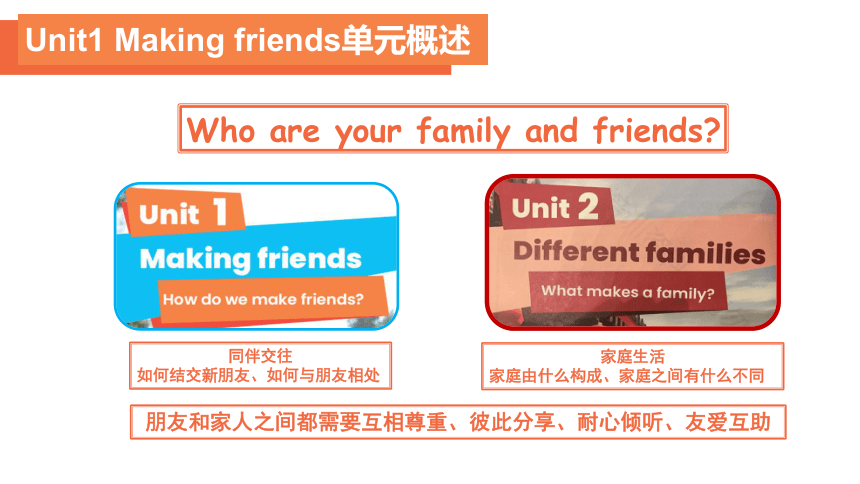
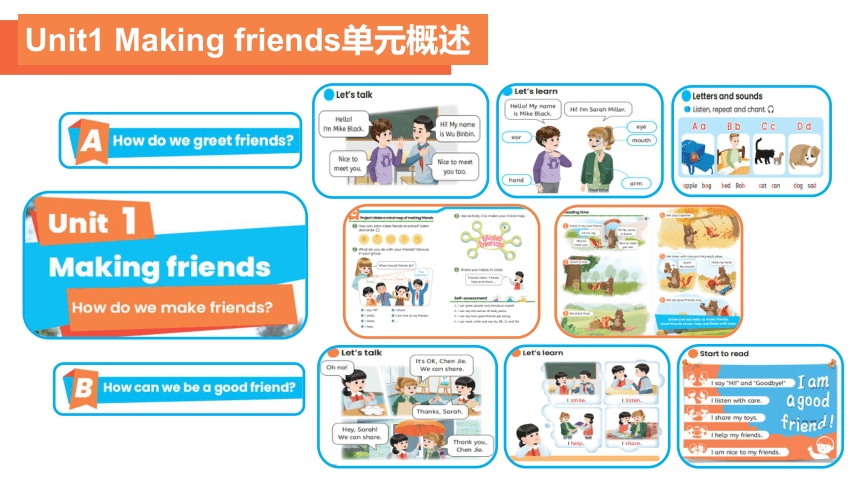
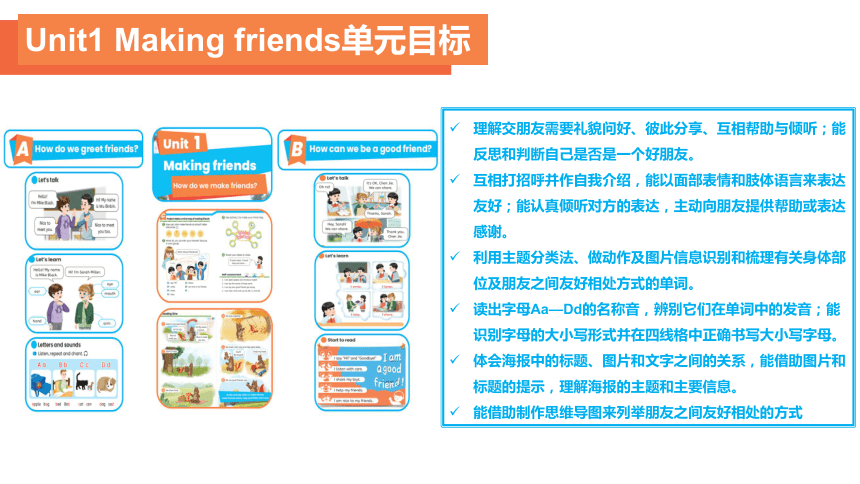
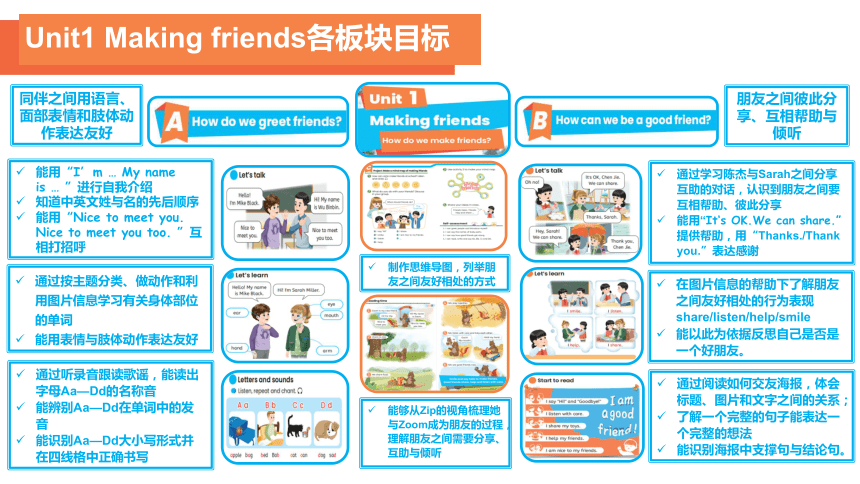
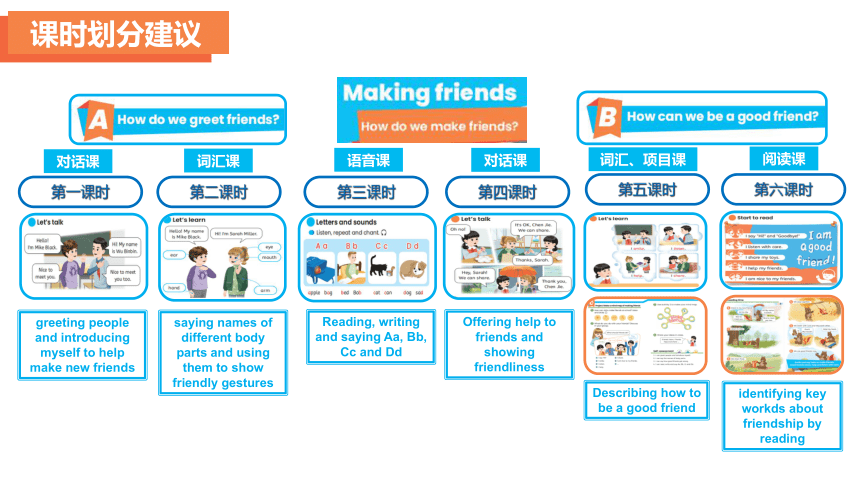
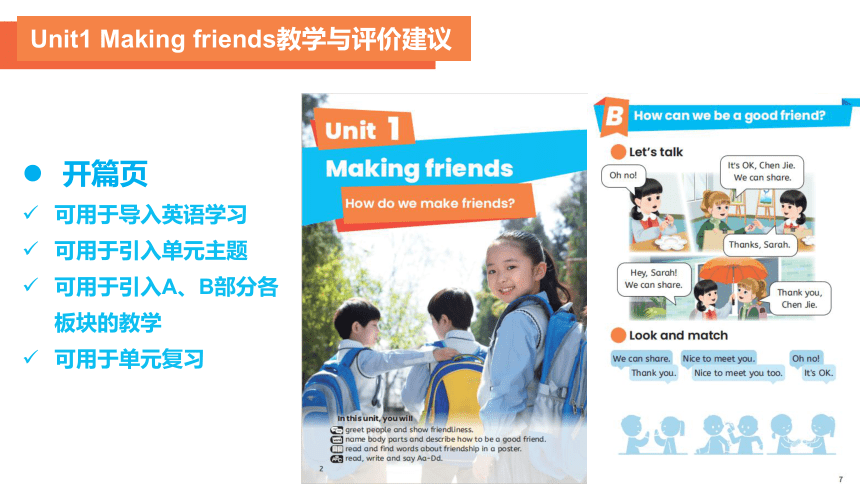
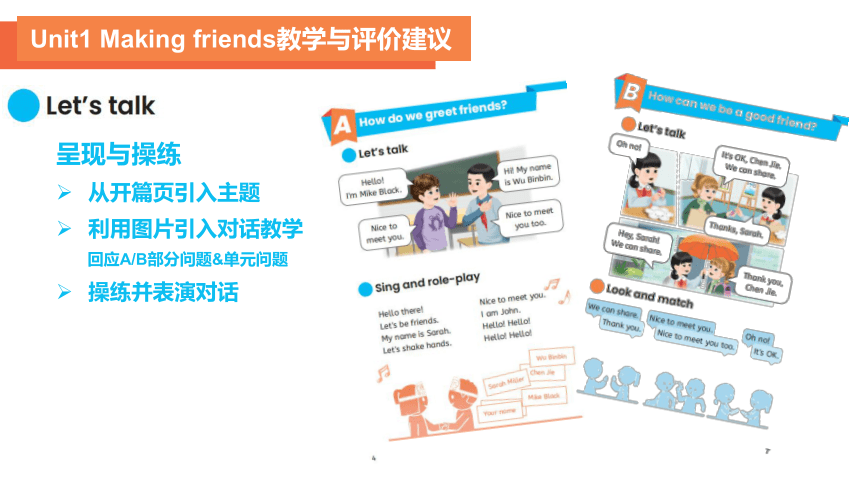
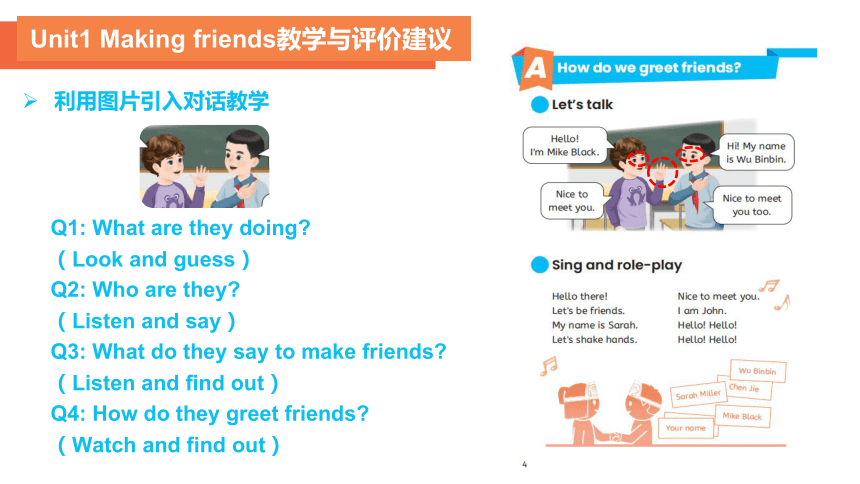
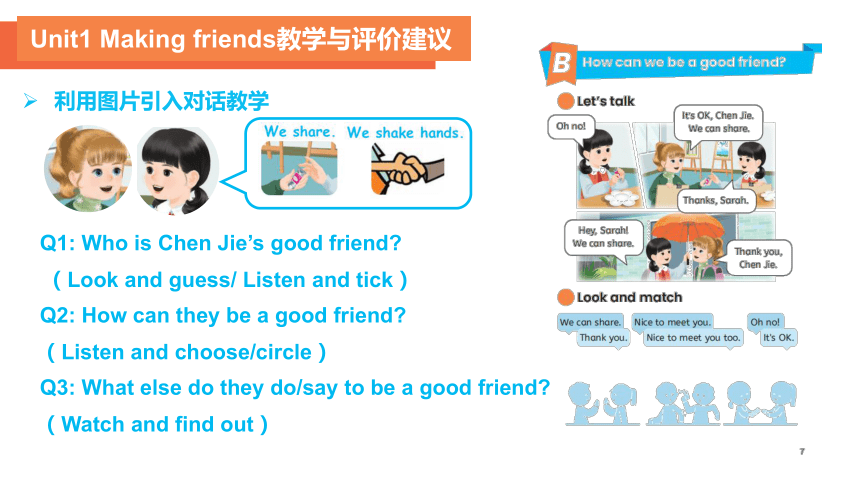
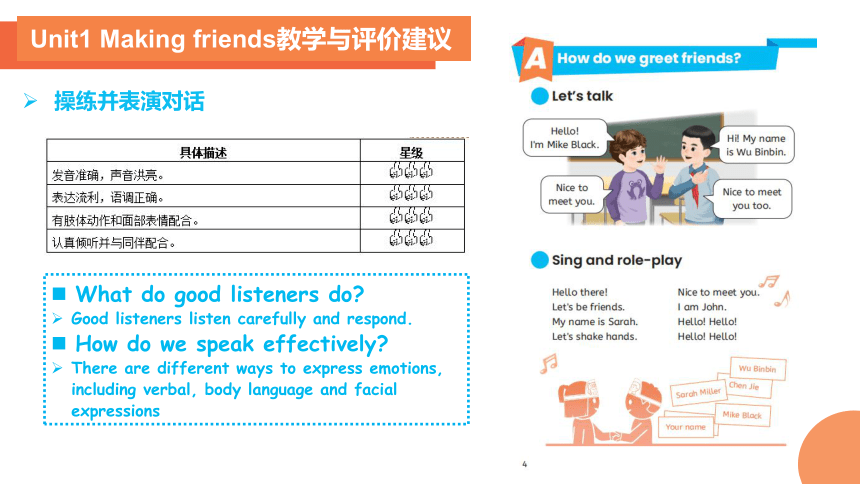
文档简介
(共36张PPT)
U1 Making friends
单元解析及教学建议
义务教育教科书 英语(PEP)三年级上册
01
02
03
单元概述
单元目标设计
教学及评价建议
Unit1 Making friends单元概述
Who are your family and friends
同伴交往
如何结交新朋友、如何与朋友相处
家庭生活
家庭由什么构成、家庭之间有什么不同
朋友和家人之间都需要互相尊重、彼此分享、耐心倾听、友爱互助
Unit1 Making friends单元概述
Unit1 Making friends单元目标
理解交朋友需要礼貌问好、彼此分享、互相帮助与倾听;能反思和判断自己是否是一个好朋友。
互相打招呼并作自我介绍,能以面部表情和肢体语言来表达友好;能认真倾听对方的表达,主动向朋友提供帮助或表达感谢。
利用主题分类法、做动作及图片信息识别和梳理有关身体部位及朋友之间友好相处方式的单词。
读出字母Aa—Dd的名称音,辨别它们在单词中的发音;能识别字母的大小写形式并在四线格中正确书写大小写字母。
体会海报中的标题、图片和文字之间的关系,能借助图片和标题的提示,理解海报的主题和主要信息。
能借助制作思维导图来列举朋友之间友好相处的方式
Unit1 Making friends各板块目标
同伴之间用语言、面部表情和肢体动作表达友好
能用“I’m … My name is … ”进行自我介绍
知道中英文姓与名的先后顺序
能用“Nice to meet you. Nice to meet you too. ”互相打招呼
通过按主题分类、做动作和利用图片信息学习有关身体部位的单词
能用表情与肢体动作表达友好
朋友之间彼此分享、互相帮助与倾听
通过听录音跟读歌谣,能读出字母Aa—Dd的名称音
能辨别Aa—Dd在单词中的发音
能识别Aa—Dd大小写形式并在四线格中正确书写
通过学习陈杰与Sarah之间分享互助的对话,认识到朋友之间要互相帮助、彼此分享
能用“It‘s OK.We can share.”提供帮助,用“Thanks./Thank you.”表达感谢
在图片信息的帮助下了解朋友之间友好相处的行为表现share/listen/help/smile
能以此为依据反思自己是否是一个好朋友。
通过阅读如何交友海报,体会标题、图片和文字之间的关系;
了解一个完整的句子能表达一个完整的想法
能识别海报中支撑句与结论句。
制作思维导图,列举朋友之间友好相处的方式
能够从Zip的视角梳理她与Zoom成为朋友的过程,理解朋友之间需要分享、互助与倾听
第一课时
第二课时
第三课时
第四课时
第五课时
第六课时
greeting people and introducing myself to help make new friends
saying names of different body parts and using them to show friendly gestures
Reading, writing and saying Aa, Bb, Cc and Dd
Offering help to friends and showing friendliness
Describing how to be a good friend
identifying key workds about friendship by reading
课时划分建议
对话课
词汇课
语音课
对话课
词汇、项目课
阅读课
开篇页
可用于导入英语学习
可用于引入单元主题
可用于引入A、B部分各板块的教学
可用于单元复习
Unit1 Making friends教学与评价建议
Unit1 Making friends教学与评价建议
呈现与操练
从开篇页引入主题
利用图片引入对话教学
回应A/B部分问题&单元问题
操练并表演对话
Q1: What are they doing
(Look and guess)
Q2: Who are they
(Listen and say)
Q3: What do they say to make friends
(Listen and find out)
Q4: How do they greet friends
(Watch and find out)
利用图片引入对话教学
Unit1 Making friends教学与评价建议
Q1: Who is Chen Jie’s good friend
(Look and guess/ Listen and tick)
Q2: How can they be a good friend
(Listen and choose/circle)
Q3: What else do they do/say to be a good friend
(Watch and find out)
利用图片引入对话教学
Unit1 Making friends教学与评价建议
操练并表演对话
What do good listeners do
Good listeners listen carefully and respond.
How do we speak effectively
There are different ways to express emotions, including verbal, body language and facial expressions
Unit1 Making friends教学与评价建议
Unit1 Making friends教学与评价建议
呈现与操练
从开篇页引入单元主题
利用图片引入对话教学
回应A/B部分问题&单元问题
操练并表演对话
巩固与拓展
延展性活动
围绕主题创编对话
延展性活动
Q1: Who is singing
(Listen and tick)
Q2: How do they greet friends
/What do they say to make friends
(Listen/Watch and say)
Sing the song
Mke a new song
Unit1 Making friends教学与评价建议
回应A/B部分问题&单元问题
围绕主题创编对话
想象如果教材中的人物来到自己的学校,自己会如何与他们交朋友,创编一段自己与教材中人物的对话。
一星(We still need help.)
二星(We can mostly do it.)
三星(We can do it!)
Unit1 Making friends教学与评价建议
呈现与操练
复习Let's talk,回顾主题
围绕主题开展单词教学
回应A/B部分问题&单元问题
Unit1 Making friends教学与评价建议
围绕主题开展单词教学
Q1: Who is Sarah’s new friend
(Listen/Watch and answer)
Q2: How do they greet friends
/What do they say to make friends
(Listen/Watch and say)
Q3: Which body parts also try to say “Hello!”
(Watch and say)
Unit1 Making friends教学与评价建议
围绕主题开展单词教学
Q1: Is Chen Jie a good friend
(Think/Look and say)
Q2: How does Chen Jie be a good friend
(Listen and choose/Watch and say)
Unit1 Making friends教学与评价建议
呈现与操练
复习Let's talk,回顾主题
围绕主题开展单词教学
回应A/B部分问题&单元问题
利用单词卡片等,在主题情境中操练音、形、义
Unit1 Making friends教学与评价建议
利用单词卡片等,在主题情境中操练音、形、义
A: Are you a good friend (出卡片)
B: Yes, I smile/listen/help/share.(做动作)
How do we develop and improve vocabulary
Words of the same category, physical actions and visuals can help us get the meaning of an unfamiliar word
Unit1 Making friends教学与评价建议
呈现与操练
复习Let's talk,回顾主题
围绕主题开展单词教学
回应A/B部分问题&单元问题
利用单词卡片等,在主题情境中操练音、形、义
巩固与拓展
延展性活动
围绕主题创编歌谣/对话
Unit1 Making friends教学与评价建议
延展性活动
Q1: How can our body parts greet friends
(Listen and say)
Q2: What’s the name of the chant
(Think and say)
Q3: Can you make a new chant
(Think and say)
Unit1 Making friends教学与评价建议
围绕主题创编歌谣、对话等
Unit1 Making friends教学与评价建议
How do readers prepare for reading
Readers prepare for reading by knowing and applying the correspondence of spoken words to printed words, the correspondence between uppercase and lowercase letters, the association of letters and sounds, and the differences between letters, words, and sentences
(掌握并运用口语中的单词与印刷的单词的对应关系,大写字母与小写字母的对应关系,字母与其发音的关系,字母、单词与句子之间的区别等,有利于做好阅读准备)
Unit1 Making friends教学与评价建议
呈现与操练
学唱歌曲、歌谣,认识字母
书写字母
通过歌曲、歌谣,了解字母在单词中的发音
操练单词拼读
巩固与拓展
延展性活动
阅读、编演phonics小故事/歌谣
Unit1 Making friends教学与评价建议
阅读、编演phonics小故事/歌谣
...
cat
ant
Unit1 Making friends教学与评价建议
Bob
dog
单元教学内容分析与教学建议
阅读、编演phonics小故事/歌谣
读前活动
利用歌曲等进入主题
读中活动
情境导入,提取主要信息
细读语篇,识别细节信息
再读语篇,关注语言结构
读后活动
延展性活动
拓展阅读
个性化表达、制作相关产品
Unit1 Making friends教学与评价建议
情境导入,提取主要信息
Q1:What is the boy doing
(Look and guess)
(Read and check)
Q2: What’s the name of the poster
(Read and guess) (Read and check)
细读语篇,识别细节信息
Q3: Which poster do you like
(Look and say)
Q4: Where are the pictures
(Read and match)
How do readers create meaning from informational texts
Titles and pictures can help understand the text
Identifying main ideas and details helps make meaning
Unit1 Making friends教学与评价建议
再读语篇,关注语言结构
Circle the words in the poster
Compare the sentences
What is a complete sentence
It helps readers prepare for reading by learning the differences between words and sentences
A complete sentence has a naming part (subject) and a telling part (a verb);
It begins with a capital letter and ends with an end mark
Unit1 Making friends教学与评价建议
拓展阅读(Reading time)
个性化表达、制作相关产品
Unit1 Making friends教学与评价建议
拆分项目活动
步骤1: ALet’s learn
步骤2&步骤3: B部分Let’s learn
步骤4: B Start to read读前活动
完整实施项目活动
任务准备
任务完成
产品展示与评价
Unit1 Making friends教学与评价建议
产品展示与评价
Unit1 Making friends教学与评价建议
融于A/B部分教学
B Let’s talk
B Start to read
用于单元复习
Unit1 Making friends教学与评价建议
Unit1 Making friends单元概述
Unit1 Making friends
THANK YOU!
U1 Making friends
单元解析及教学建议
义务教育教科书 英语(PEP)三年级上册
01
02
03
单元概述
单元目标设计
教学及评价建议
Unit1 Making friends单元概述
Who are your family and friends
同伴交往
如何结交新朋友、如何与朋友相处
家庭生活
家庭由什么构成、家庭之间有什么不同
朋友和家人之间都需要互相尊重、彼此分享、耐心倾听、友爱互助
Unit1 Making friends单元概述
Unit1 Making friends单元目标
理解交朋友需要礼貌问好、彼此分享、互相帮助与倾听;能反思和判断自己是否是一个好朋友。
互相打招呼并作自我介绍,能以面部表情和肢体语言来表达友好;能认真倾听对方的表达,主动向朋友提供帮助或表达感谢。
利用主题分类法、做动作及图片信息识别和梳理有关身体部位及朋友之间友好相处方式的单词。
读出字母Aa—Dd的名称音,辨别它们在单词中的发音;能识别字母的大小写形式并在四线格中正确书写大小写字母。
体会海报中的标题、图片和文字之间的关系,能借助图片和标题的提示,理解海报的主题和主要信息。
能借助制作思维导图来列举朋友之间友好相处的方式
Unit1 Making friends各板块目标
同伴之间用语言、面部表情和肢体动作表达友好
能用“I’m … My name is … ”进行自我介绍
知道中英文姓与名的先后顺序
能用“Nice to meet you. Nice to meet you too. ”互相打招呼
通过按主题分类、做动作和利用图片信息学习有关身体部位的单词
能用表情与肢体动作表达友好
朋友之间彼此分享、互相帮助与倾听
通过听录音跟读歌谣,能读出字母Aa—Dd的名称音
能辨别Aa—Dd在单词中的发音
能识别Aa—Dd大小写形式并在四线格中正确书写
通过学习陈杰与Sarah之间分享互助的对话,认识到朋友之间要互相帮助、彼此分享
能用“It‘s OK.We can share.”提供帮助,用“Thanks./Thank you.”表达感谢
在图片信息的帮助下了解朋友之间友好相处的行为表现share/listen/help/smile
能以此为依据反思自己是否是一个好朋友。
通过阅读如何交友海报,体会标题、图片和文字之间的关系;
了解一个完整的句子能表达一个完整的想法
能识别海报中支撑句与结论句。
制作思维导图,列举朋友之间友好相处的方式
能够从Zip的视角梳理她与Zoom成为朋友的过程,理解朋友之间需要分享、互助与倾听
第一课时
第二课时
第三课时
第四课时
第五课时
第六课时
greeting people and introducing myself to help make new friends
saying names of different body parts and using them to show friendly gestures
Reading, writing and saying Aa, Bb, Cc and Dd
Offering help to friends and showing friendliness
Describing how to be a good friend
identifying key workds about friendship by reading
课时划分建议
对话课
词汇课
语音课
对话课
词汇、项目课
阅读课
开篇页
可用于导入英语学习
可用于引入单元主题
可用于引入A、B部分各板块的教学
可用于单元复习
Unit1 Making friends教学与评价建议
Unit1 Making friends教学与评价建议
呈现与操练
从开篇页引入主题
利用图片引入对话教学
回应A/B部分问题&单元问题
操练并表演对话
Q1: What are they doing
(Look and guess)
Q2: Who are they
(Listen and say)
Q3: What do they say to make friends
(Listen and find out)
Q4: How do they greet friends
(Watch and find out)
利用图片引入对话教学
Unit1 Making friends教学与评价建议
Q1: Who is Chen Jie’s good friend
(Look and guess/ Listen and tick)
Q2: How can they be a good friend
(Listen and choose/circle)
Q3: What else do they do/say to be a good friend
(Watch and find out)
利用图片引入对话教学
Unit1 Making friends教学与评价建议
操练并表演对话
What do good listeners do
Good listeners listen carefully and respond.
How do we speak effectively
There are different ways to express emotions, including verbal, body language and facial expressions
Unit1 Making friends教学与评价建议
Unit1 Making friends教学与评价建议
呈现与操练
从开篇页引入单元主题
利用图片引入对话教学
回应A/B部分问题&单元问题
操练并表演对话
巩固与拓展
延展性活动
围绕主题创编对话
延展性活动
Q1: Who is singing
(Listen and tick)
Q2: How do they greet friends
/What do they say to make friends
(Listen/Watch and say)
Sing the song
Mke a new song
Unit1 Making friends教学与评价建议
回应A/B部分问题&单元问题
围绕主题创编对话
想象如果教材中的人物来到自己的学校,自己会如何与他们交朋友,创编一段自己与教材中人物的对话。
一星(We still need help.)
二星(We can mostly do it.)
三星(We can do it!)
Unit1 Making friends教学与评价建议
呈现与操练
复习Let's talk,回顾主题
围绕主题开展单词教学
回应A/B部分问题&单元问题
Unit1 Making friends教学与评价建议
围绕主题开展单词教学
Q1: Who is Sarah’s new friend
(Listen/Watch and answer)
Q2: How do they greet friends
/What do they say to make friends
(Listen/Watch and say)
Q3: Which body parts also try to say “Hello!”
(Watch and say)
Unit1 Making friends教学与评价建议
围绕主题开展单词教学
Q1: Is Chen Jie a good friend
(Think/Look and say)
Q2: How does Chen Jie be a good friend
(Listen and choose/Watch and say)
Unit1 Making friends教学与评价建议
呈现与操练
复习Let's talk,回顾主题
围绕主题开展单词教学
回应A/B部分问题&单元问题
利用单词卡片等,在主题情境中操练音、形、义
Unit1 Making friends教学与评价建议
利用单词卡片等,在主题情境中操练音、形、义
A: Are you a good friend (出卡片)
B: Yes, I smile/listen/help/share.(做动作)
How do we develop and improve vocabulary
Words of the same category, physical actions and visuals can help us get the meaning of an unfamiliar word
Unit1 Making friends教学与评价建议
呈现与操练
复习Let's talk,回顾主题
围绕主题开展单词教学
回应A/B部分问题&单元问题
利用单词卡片等,在主题情境中操练音、形、义
巩固与拓展
延展性活动
围绕主题创编歌谣/对话
Unit1 Making friends教学与评价建议
延展性活动
Q1: How can our body parts greet friends
(Listen and say)
Q2: What’s the name of the chant
(Think and say)
Q3: Can you make a new chant
(Think and say)
Unit1 Making friends教学与评价建议
围绕主题创编歌谣、对话等
Unit1 Making friends教学与评价建议
How do readers prepare for reading
Readers prepare for reading by knowing and applying the correspondence of spoken words to printed words, the correspondence between uppercase and lowercase letters, the association of letters and sounds, and the differences between letters, words, and sentences
(掌握并运用口语中的单词与印刷的单词的对应关系,大写字母与小写字母的对应关系,字母与其发音的关系,字母、单词与句子之间的区别等,有利于做好阅读准备)
Unit1 Making friends教学与评价建议
呈现与操练
学唱歌曲、歌谣,认识字母
书写字母
通过歌曲、歌谣,了解字母在单词中的发音
操练单词拼读
巩固与拓展
延展性活动
阅读、编演phonics小故事/歌谣
Unit1 Making friends教学与评价建议
阅读、编演phonics小故事/歌谣
...
cat
ant
Unit1 Making friends教学与评价建议
Bob
dog
单元教学内容分析与教学建议
阅读、编演phonics小故事/歌谣
读前活动
利用歌曲等进入主题
读中活动
情境导入,提取主要信息
细读语篇,识别细节信息
再读语篇,关注语言结构
读后活动
延展性活动
拓展阅读
个性化表达、制作相关产品
Unit1 Making friends教学与评价建议
情境导入,提取主要信息
Q1:What is the boy doing
(Look and guess)
(Read and check)
Q2: What’s the name of the poster
(Read and guess) (Read and check)
细读语篇,识别细节信息
Q3: Which poster do you like
(Look and say)
Q4: Where are the pictures
(Read and match)
How do readers create meaning from informational texts
Titles and pictures can help understand the text
Identifying main ideas and details helps make meaning
Unit1 Making friends教学与评价建议
再读语篇,关注语言结构
Circle the words in the poster
Compare the sentences
What is a complete sentence
It helps readers prepare for reading by learning the differences between words and sentences
A complete sentence has a naming part (subject) and a telling part (a verb);
It begins with a capital letter and ends with an end mark
Unit1 Making friends教学与评价建议
拓展阅读(Reading time)
个性化表达、制作相关产品
Unit1 Making friends教学与评价建议
拆分项目活动
步骤1: ALet’s learn
步骤2&步骤3: B部分Let’s learn
步骤4: B Start to read读前活动
完整实施项目活动
任务准备
任务完成
产品展示与评价
Unit1 Making friends教学与评价建议
产品展示与评价
Unit1 Making friends教学与评价建议
融于A/B部分教学
B Let’s talk
B Start to read
用于单元复习
Unit1 Making friends教学与评价建议
Unit1 Making friends单元概述
Unit1 Making friends
THANK YOU!
同课章节目录
